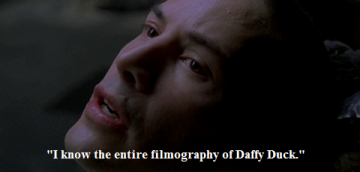
I would know a whole lot less if Wikipedia didn't exist. A day rarely passes by without something piquing my interest and then suddenly I'm learning all about the mating rituals of porpoises. It's almost like how Neo learns Kung Fu in The Matrix. I open up a Wikipedia page and then boom:

Now, every once in a while, I stumble across a Wikipedia article that is exceptionally interesting. I call these WikiNuggets. They are absolute gems of often useless yet incredibly satisfying information. This is because Sir Wiki the Pedia has such a crafty way with words. And he is at his anecdotal best when explaining the seemingly mundane, spinning inconsequential matters into elegant prose.
Take for example, this sentence on the act of jumping:
"Some animals, such as the kangaroo, employ jumping (commonly called hopping in this instance) as their primary form of locomotion, while others, such as frogs, use it only as a means to escape predators."
I knew this already. I knew that kangaroos jump places to get around. And right before reading that little part about hopping, I was thinking to myself, "Now, hold on a minute there, Wikipedia. Kangaroos... jumping?? I would be more inclined to use a word like h- oh. Nevermind."
That is the beauty of Wikipedia. It can tell me something I already know and yet I feel like I am still learning just because I never thought anyone would bother writing it down.
So I've decided to compile a short list of some of the best WikiNuggets I've read over the past couple of weeks.
I actually looked up "stairs" yesterday after thinking about how awesome stairs are. They're so helpful. Have you ever tried getting upstairs without stairs? It's hard.
I was hooked by the first sentence: "A stairway is a construction designed to bridge a large vertical distance by dividing it into smaller vertical distances, called steps." This is so true.
I was a little disappointed that the article didn't have a decent "History of Stairs" section, but the rest is interesting. The "Notable Sets of Stairs" section is great. Try to read it without reflecting on what you're currently doing though ("I am reading a list of notable sets of stairs.").
This article has a wonderful description of shorts at the bottom of the opening paragraph: "Shorts are typically worn in warm weather or in an environment where comfort and airflow are more important than the protection of the legs." I think all of us quickly go through that logic every time we put on shorts and we just don't realize it.
I kind of want to walk up to a stranger wearing shorts and say, "Comfort and airflow are obviously more important to you at the moment than the protection of your legs."
Aside from it being interesting to read an objective article on your own species, the best part of this article might be the picture chosen to represent us. Couldn't we have chosen someone happier? This guy's all like, "I'm a human. Booooo."
The quintessential human.
I wonder if other animals would be embarrassed by the pictures chosen to represent their species on Wikipedia. "Aw, what?! They put a picture of Frank up there? I can think of, just off the top of my head, at least 50 better turtles."
I looked this one up while sitting on the toilet staring at my bath towel. I can honestly say I had no idea what I was getting into. The article lists and describes 16 different kinds of towels, not to mention 15 "alternative uses." Just to give you an idea of the kind of mind-blowing stuff you'll read in this article, here's an example of one of the alternative uses:
A towel can act as a makeshift garment or blanket. There is a variety of uses when a towel is applied in this manner. For example, the towel can be used as an extra layer of clothing for cold conditions; or can be worn on its own around the waist (similarly to a kilt or skirt) or just under the shoulders (similarly to a long dress), usually in a warm environment.
To be fair, one of the alternative uses listed was quite literally mind-blowing. Well, not literally, I guess. That would be deadly. But my mind was at least metaphorically blown. It states:
"On cruise ships, towel animals are created for the patrons."
Naturally, I clicked on the link to "towel animals" and, well, I don't want to ruin the surprise, but it might be the greatest thing I've ever seen. Please click here.
That towel looked like a monkey! Hanging from a hanger! And did you see those two peacocks??! They were kissing and it made it look like a heart! Those are towels!
It's things like towel animals that keep me coming back to Wikipedia day after day. You think you know everything there is to know about something, but it turns out you're just one click away from towel animals.
That's it for now. Another volume of WikiNuggets may be coming along sometime in the future.
In the mean time, Wikipedia's got me so excited it's making me sweaty. I'm going to go use a towel to dry off. Or maybe do 16 entirely different things.
If you liked this, you can read my my other stuff here. You can also follow me on Twitter (@tim_mattingly_). I have a pretty decent good tweet to bad tweet ratio. You can also subscribe to my Huffington Post blog by "liking" me and then you get an update every time I post something. Plus, all the cool kids are doing it.
